Analysis of Actuarial Science Graduation at Colchester University
VerifiedAdded on 2020/10/15
|5
|1363
|347
Report
AI Summary
This report provides an in-depth analysis of an actuarial science graduation at Colchester University, focusing on the experiences of a student named Mark Don. The report details the pre-rite preparation, including academic achievements, research participation, and extra coursework undertaken by the interviewee. It describes the rite of passage itself, covering the necessary clearances, panel discussions, and practical examinations. Furthermore, the report examines the post-rite practices, such as the conjure examination, and analyzes the graduation process through Van Gennep's phases of transition: separation, transition, and reincorporation. The student's journey is described with emphasis on the transformation and communitas formed during the liminal period, highlighting the importance of academic performance, support from lecturers and peers, and the ultimate reincorporation into the actuarial science profession.
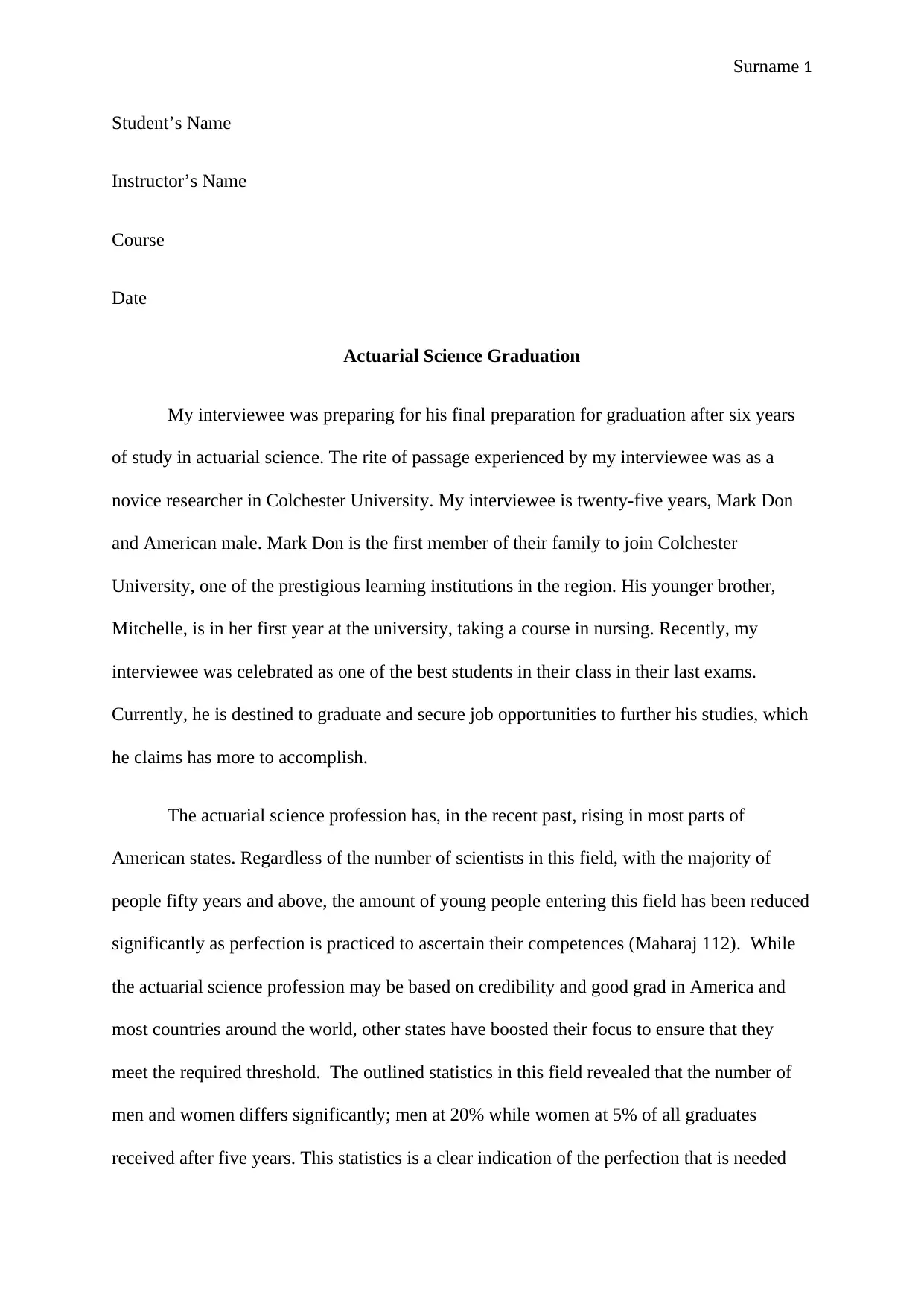
Surname 1
Student’s Name
Instructor’s Name
Course
Date
Actuarial Science Graduation
My interviewee was preparing for his final preparation for graduation after six years
of study in actuarial science. The rite of passage experienced by my interviewee was as a
novice researcher in Colchester University. My interviewee is twenty-five years, Mark Don
and American male. Mark Don is the first member of their family to join Colchester
University, one of the prestigious learning institutions in the region. His younger brother,
Mitchelle, is in her first year at the university, taking a course in nursing. Recently, my
interviewee was celebrated as one of the best students in their class in their last exams.
Currently, he is destined to graduate and secure job opportunities to further his studies, which
he claims has more to accomplish.
The actuarial science profession has, in the recent past, rising in most parts of
American states. Regardless of the number of scientists in this field, with the majority of
people fifty years and above, the amount of young people entering this field has been reduced
significantly as perfection is practiced to ascertain their competences (Maharaj 112). While
the actuarial science profession may be based on credibility and good grad in America and
most countries around the world, other states have boosted their focus to ensure that they
meet the required threshold. The outlined statistics in this field revealed that the number of
men and women differs significantly; men at 20% while women at 5% of all graduates
received after five years. This statistics is a clear indication of the perfection that is needed
Student’s Name
Instructor’s Name
Course
Date
Actuarial Science Graduation
My interviewee was preparing for his final preparation for graduation after six years
of study in actuarial science. The rite of passage experienced by my interviewee was as a
novice researcher in Colchester University. My interviewee is twenty-five years, Mark Don
and American male. Mark Don is the first member of their family to join Colchester
University, one of the prestigious learning institutions in the region. His younger brother,
Mitchelle, is in her first year at the university, taking a course in nursing. Recently, my
interviewee was celebrated as one of the best students in their class in their last exams.
Currently, he is destined to graduate and secure job opportunities to further his studies, which
he claims has more to accomplish.
The actuarial science profession has, in the recent past, rising in most parts of
American states. Regardless of the number of scientists in this field, with the majority of
people fifty years and above, the amount of young people entering this field has been reduced
significantly as perfection is practiced to ascertain their competences (Maharaj 112). While
the actuarial science profession may be based on credibility and good grad in America and
most countries around the world, other states have boosted their focus to ensure that they
meet the required threshold. The outlined statistics in this field revealed that the number of
men and women differs significantly; men at 20% while women at 5% of all graduates
received after five years. This statistics is a clear indication of the perfection that is needed
Paraphrase This Document
Need a fresh take? Get an instant paraphrase of this document with our AI Paraphraser
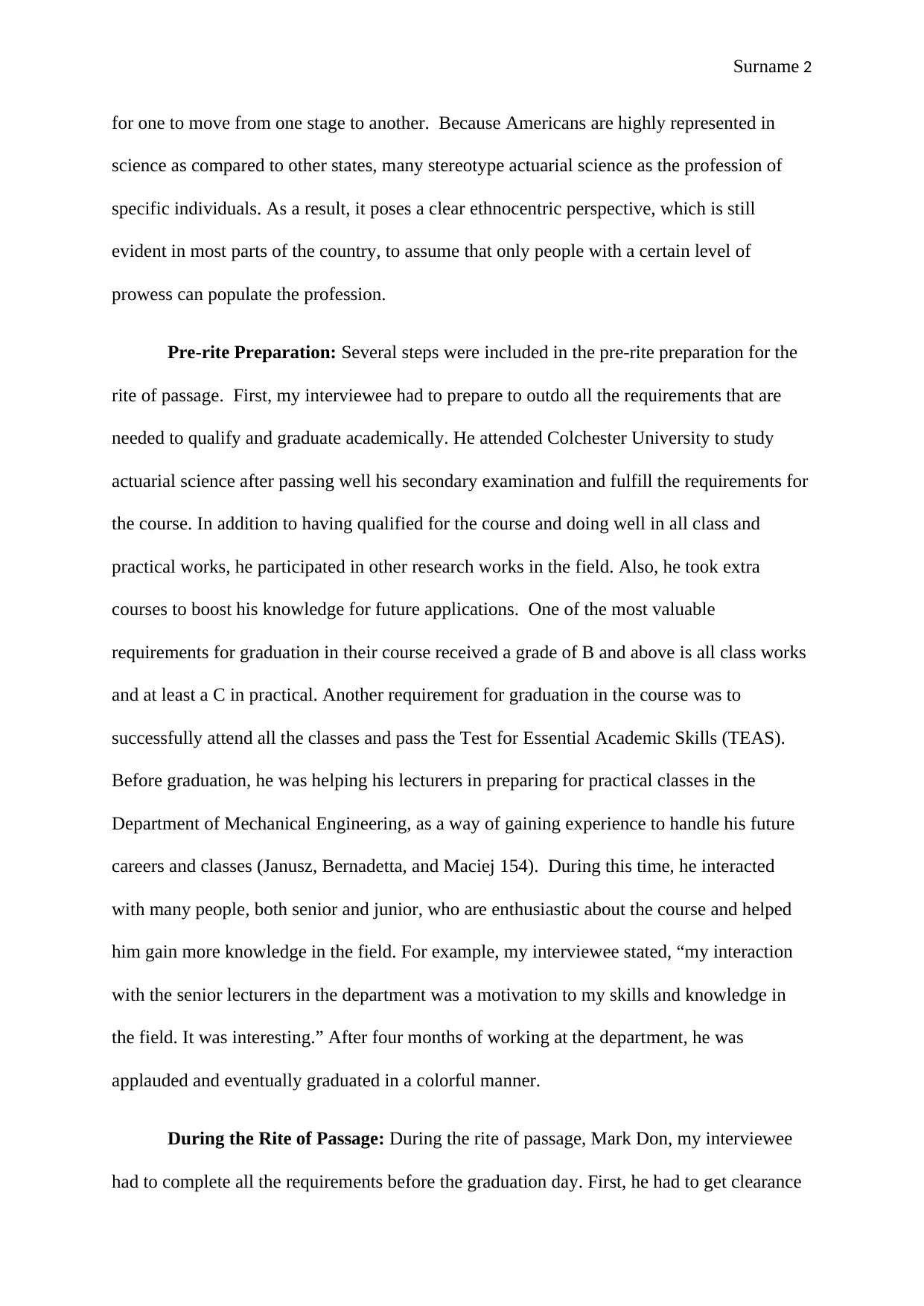
Surname 2
for one to move from one stage to another. Because Americans are highly represented in
science as compared to other states, many stereotype actuarial science as the profession of
specific individuals. As a result, it poses a clear ethnocentric perspective, which is still
evident in most parts of the country, to assume that only people with a certain level of
prowess can populate the profession.
Pre-rite Preparation: Several steps were included in the pre-rite preparation for the
rite of passage. First, my interviewee had to prepare to outdo all the requirements that are
needed to qualify and graduate academically. He attended Colchester University to study
actuarial science after passing well his secondary examination and fulfill the requirements for
the course. In addition to having qualified for the course and doing well in all class and
practical works, he participated in other research works in the field. Also, he took extra
courses to boost his knowledge for future applications. One of the most valuable
requirements for graduation in their course received a grade of B and above is all class works
and at least a C in practical. Another requirement for graduation in the course was to
successfully attend all the classes and pass the Test for Essential Academic Skills (TEAS).
Before graduation, he was helping his lecturers in preparing for practical classes in the
Department of Mechanical Engineering, as a way of gaining experience to handle his future
careers and classes (Janusz, Bernadetta, and Maciej 154). During this time, he interacted
with many people, both senior and junior, who are enthusiastic about the course and helped
him gain more knowledge in the field. For example, my interviewee stated, “my interaction
with the senior lecturers in the department was a motivation to my skills and knowledge in
the field. It was interesting.” After four months of working at the department, he was
applauded and eventually graduated in a colorful manner.
During the Rite of Passage: During the rite of passage, Mark Don, my interviewee
had to complete all the requirements before the graduation day. First, he had to get clearance
for one to move from one stage to another. Because Americans are highly represented in
science as compared to other states, many stereotype actuarial science as the profession of
specific individuals. As a result, it poses a clear ethnocentric perspective, which is still
evident in most parts of the country, to assume that only people with a certain level of
prowess can populate the profession.
Pre-rite Preparation: Several steps were included in the pre-rite preparation for the
rite of passage. First, my interviewee had to prepare to outdo all the requirements that are
needed to qualify and graduate academically. He attended Colchester University to study
actuarial science after passing well his secondary examination and fulfill the requirements for
the course. In addition to having qualified for the course and doing well in all class and
practical works, he participated in other research works in the field. Also, he took extra
courses to boost his knowledge for future applications. One of the most valuable
requirements for graduation in their course received a grade of B and above is all class works
and at least a C in practical. Another requirement for graduation in the course was to
successfully attend all the classes and pass the Test for Essential Academic Skills (TEAS).
Before graduation, he was helping his lecturers in preparing for practical classes in the
Department of Mechanical Engineering, as a way of gaining experience to handle his future
careers and classes (Janusz, Bernadetta, and Maciej 154). During this time, he interacted
with many people, both senior and junior, who are enthusiastic about the course and helped
him gain more knowledge in the field. For example, my interviewee stated, “my interaction
with the senior lecturers in the department was a motivation to my skills and knowledge in
the field. It was interesting.” After four months of working at the department, he was
applauded and eventually graduated in a colorful manner.
During the Rite of Passage: During the rite of passage, Mark Don, my interviewee
had to complete all the requirements before the graduation day. First, he had to get clearance
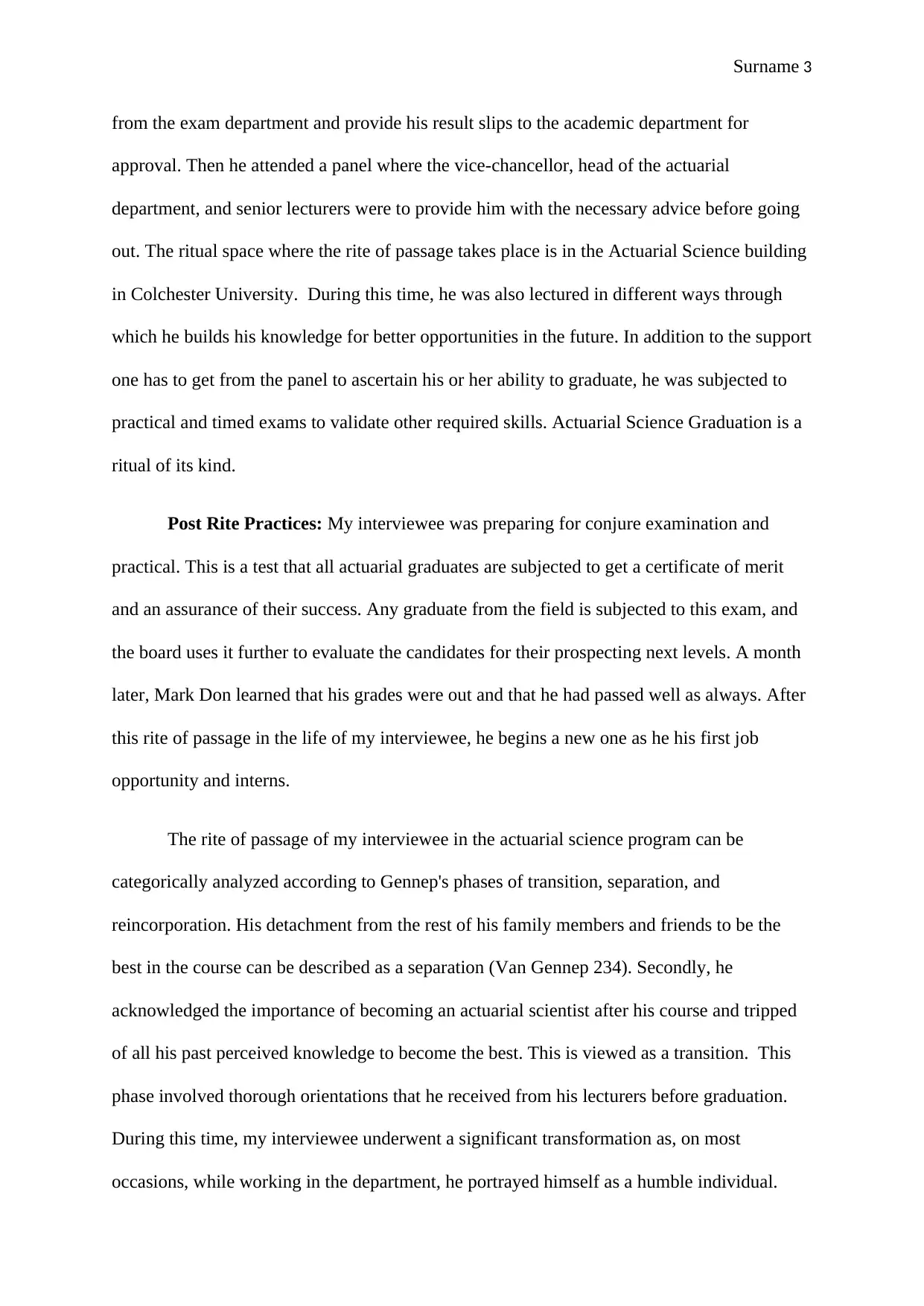
Surname 3
from the exam department and provide his result slips to the academic department for
approval. Then he attended a panel where the vice-chancellor, head of the actuarial
department, and senior lecturers were to provide him with the necessary advice before going
out. The ritual space where the rite of passage takes place is in the Actuarial Science building
in Colchester University. During this time, he was also lectured in different ways through
which he builds his knowledge for better opportunities in the future. In addition to the support
one has to get from the panel to ascertain his or her ability to graduate, he was subjected to
practical and timed exams to validate other required skills. Actuarial Science Graduation is a
ritual of its kind.
Post Rite Practices: My interviewee was preparing for conjure examination and
practical. This is a test that all actuarial graduates are subjected to get a certificate of merit
and an assurance of their success. Any graduate from the field is subjected to this exam, and
the board uses it further to evaluate the candidates for their prospecting next levels. A month
later, Mark Don learned that his grades were out and that he had passed well as always. After
this rite of passage in the life of my interviewee, he begins a new one as he his first job
opportunity and interns.
The rite of passage of my interviewee in the actuarial science program can be
categorically analyzed according to Gennep's phases of transition, separation, and
reincorporation. His detachment from the rest of his family members and friends to be the
best in the course can be described as a separation (Van Gennep 234). Secondly, he
acknowledged the importance of becoming an actuarial scientist after his course and tripped
of all his past perceived knowledge to become the best. This is viewed as a transition. This
phase involved thorough orientations that he received from his lecturers before graduation.
During this time, my interviewee underwent a significant transformation as, on most
occasions, while working in the department, he portrayed himself as a humble individual.
from the exam department and provide his result slips to the academic department for
approval. Then he attended a panel where the vice-chancellor, head of the actuarial
department, and senior lecturers were to provide him with the necessary advice before going
out. The ritual space where the rite of passage takes place is in the Actuarial Science building
in Colchester University. During this time, he was also lectured in different ways through
which he builds his knowledge for better opportunities in the future. In addition to the support
one has to get from the panel to ascertain his or her ability to graduate, he was subjected to
practical and timed exams to validate other required skills. Actuarial Science Graduation is a
ritual of its kind.
Post Rite Practices: My interviewee was preparing for conjure examination and
practical. This is a test that all actuarial graduates are subjected to get a certificate of merit
and an assurance of their success. Any graduate from the field is subjected to this exam, and
the board uses it further to evaluate the candidates for their prospecting next levels. A month
later, Mark Don learned that his grades were out and that he had passed well as always. After
this rite of passage in the life of my interviewee, he begins a new one as he his first job
opportunity and interns.
The rite of passage of my interviewee in the actuarial science program can be
categorically analyzed according to Gennep's phases of transition, separation, and
reincorporation. His detachment from the rest of his family members and friends to be the
best in the course can be described as a separation (Van Gennep 234). Secondly, he
acknowledged the importance of becoming an actuarial scientist after his course and tripped
of all his past perceived knowledge to become the best. This is viewed as a transition. This
phase involved thorough orientations that he received from his lecturers before graduation.
During this time, my interviewee underwent a significant transformation as, on most
occasions, while working in the department, he portrayed himself as a humble individual.
⊘ This is a preview!⊘
Do you want full access?
Subscribe today to unlock all pages.

Trusted by 1+ million students worldwide
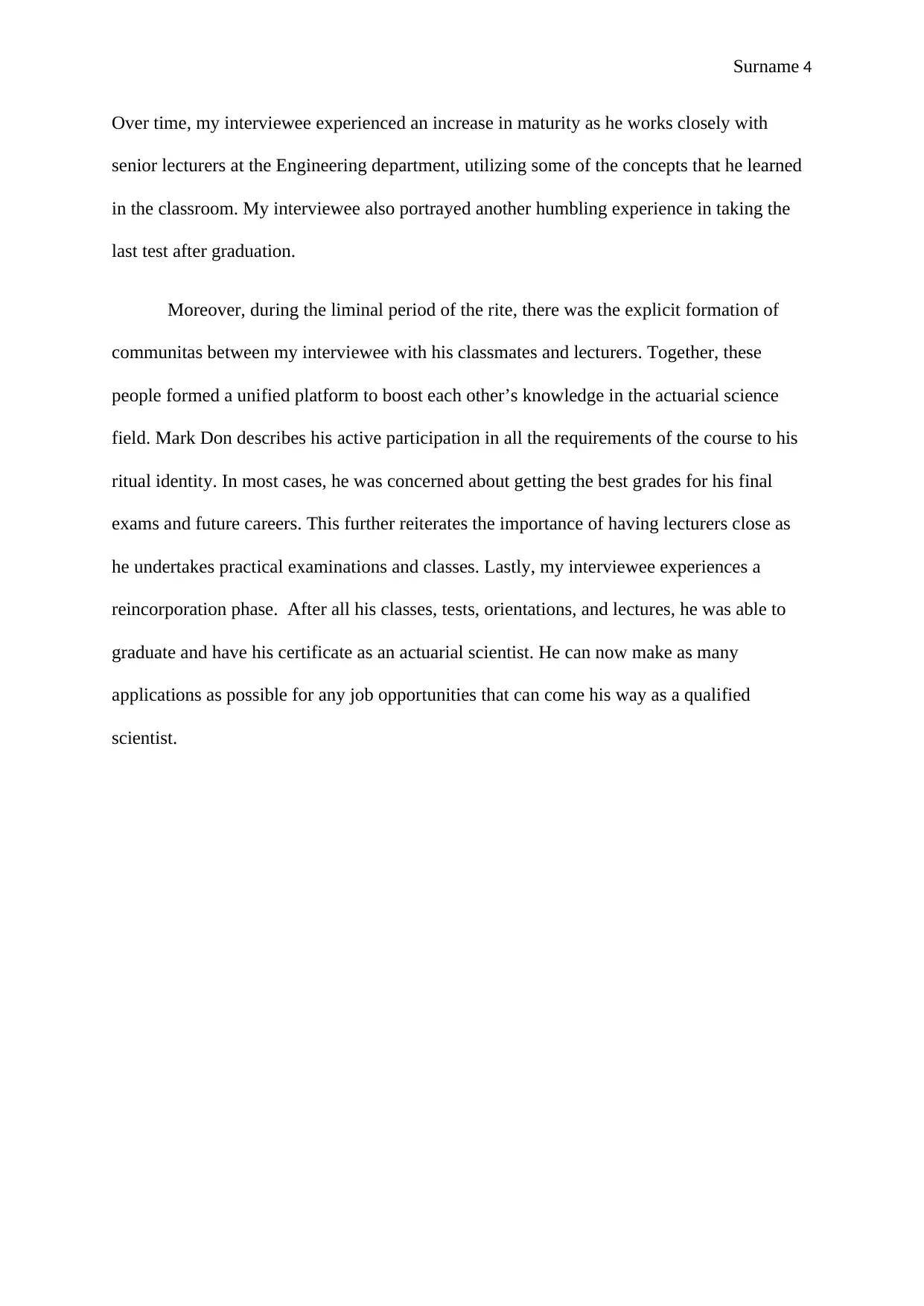
Surname 4
Over time, my interviewee experienced an increase in maturity as he works closely with
senior lecturers at the Engineering department, utilizing some of the concepts that he learned
in the classroom. My interviewee also portrayed another humbling experience in taking the
last test after graduation.
Moreover, during the liminal period of the rite, there was the explicit formation of
communitas between my interviewee with his classmates and lecturers. Together, these
people formed a unified platform to boost each other’s knowledge in the actuarial science
field. Mark Don describes his active participation in all the requirements of the course to his
ritual identity. In most cases, he was concerned about getting the best grades for his final
exams and future careers. This further reiterates the importance of having lecturers close as
he undertakes practical examinations and classes. Lastly, my interviewee experiences a
reincorporation phase. After all his classes, tests, orientations, and lectures, he was able to
graduate and have his certificate as an actuarial scientist. He can now make as many
applications as possible for any job opportunities that can come his way as a qualified
scientist.
Over time, my interviewee experienced an increase in maturity as he works closely with
senior lecturers at the Engineering department, utilizing some of the concepts that he learned
in the classroom. My interviewee also portrayed another humbling experience in taking the
last test after graduation.
Moreover, during the liminal period of the rite, there was the explicit formation of
communitas between my interviewee with his classmates and lecturers. Together, these
people formed a unified platform to boost each other’s knowledge in the actuarial science
field. Mark Don describes his active participation in all the requirements of the course to his
ritual identity. In most cases, he was concerned about getting the best grades for his final
exams and future careers. This further reiterates the importance of having lecturers close as
he undertakes practical examinations and classes. Lastly, my interviewee experiences a
reincorporation phase. After all his classes, tests, orientations, and lectures, he was able to
graduate and have his certificate as an actuarial scientist. He can now make as many
applications as possible for any job opportunities that can come his way as a qualified
scientist.
Paraphrase This Document
Need a fresh take? Get an instant paraphrase of this document with our AI Paraphraser
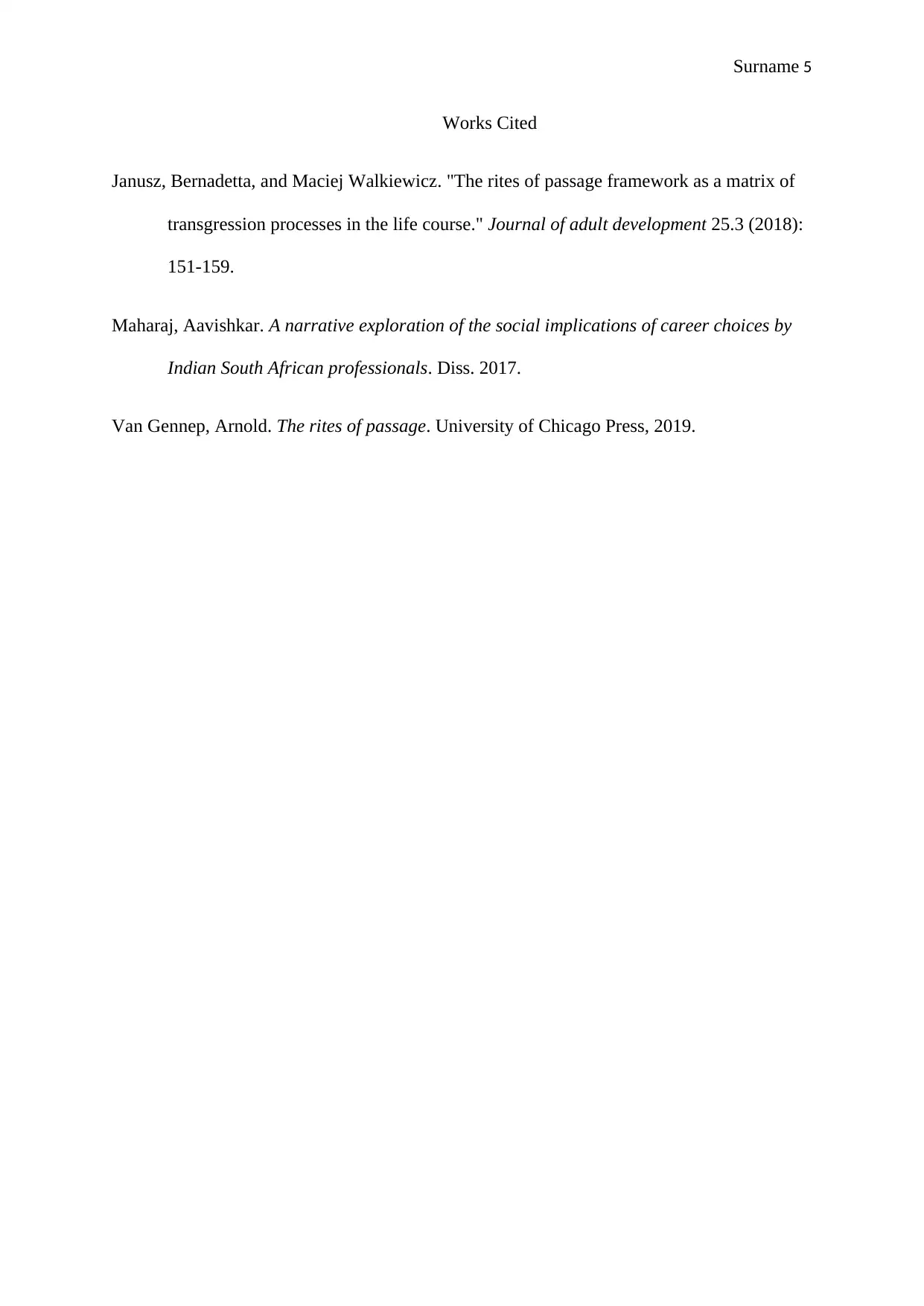
Surname 5
Works Cited
Janusz, Bernadetta, and Maciej Walkiewicz. "The rites of passage framework as a matrix of
transgression processes in the life course." Journal of adult development 25.3 (2018):
151-159.
Maharaj, Aavishkar. A narrative exploration of the social implications of career choices by
Indian South African professionals. Diss. 2017.
Van Gennep, Arnold. The rites of passage. University of Chicago Press, 2019.
Works Cited
Janusz, Bernadetta, and Maciej Walkiewicz. "The rites of passage framework as a matrix of
transgression processes in the life course." Journal of adult development 25.3 (2018):
151-159.
Maharaj, Aavishkar. A narrative exploration of the social implications of career choices by
Indian South African professionals. Diss. 2017.
Van Gennep, Arnold. The rites of passage. University of Chicago Press, 2019.
1 out of 5
Your All-in-One AI-Powered Toolkit for Academic Success.
+13062052269
info@desklib.com
Available 24*7 on WhatsApp / Email
![[object Object]](/_next/static/media/star-bottom.7253800d.svg)
Unlock your academic potential
Copyright © 2020–2025 A2Z Services. All Rights Reserved. Developed and managed by ZUCOL.